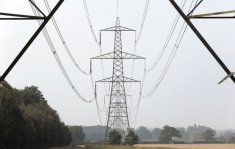
However, supply should not be affected by this scenario.
The definitive version of the snowmelt forecast that CDEC-SIC will release this week would point to a worsening of the drought conditions on flows.
Source:
Diario Financiero
– Monday, October 7, 2013 |
By: J. Esturillo / J.C Pardo
The fourth consecutive year of drought in the country continues to leave its effects on the main generation and mixed reservoirs (also used for irrigation) of the Central Interconnected System (SIC), which supplies more than 94% of the national population.
Thus, last September the energy stored in six of these types of dams reached its lowest level since 1998, which is considered the driest year on record in terms of inflowing energy (rain, snow and flows).
According to statistics from the consulting firm Systep, in that month the energy contained in the Colbún, Rapel, Ralco and Laguna La Invernada reservoirs, as well as the Laja and Chapo lakes, totaled 763 GWh, the second lowest volume since 1998. That year the situation of drought and lack of backup thermal capacity became so critical that it led to the application of effective rationing, i.e., the application of programmed outages that lasted from November of that year to July 1999.
In order to have an idea of what these levels of dammed energy represent, it can be indicated that during 2013 the monthly gross generation in the SIC has ranged between 4,000 and 4,300 GWh.
For example, in September 2006, which was registered as a wet year, the energy accumulated in dams reached 7,700 GWh, according to the same statistics.
“The share of hydroelectric power plants decreased from 39% in July to 36% in August, which is also lower compared to the same month in 2012 (42%). Reservoirs remain at critical levels, with only a marginal increase in water levels characteristic of the winter months,” said the consulting firm linked to academic Hugh Rudnick in its September monthly report.
Security and costs
When analyzing the implications that this drop in energy levels may have on the system, the safety variable is raised.
This, considering that hydroelectric power plants play an important role in regulating the frequency of the system, due to their faster response capacity to inject or withdraw energy in case of disturbances.
On this point, electricity specialists explain that this role has become less critical as the natural gas and diesel fleet has increased (see related story).
They add that, in general terms, supply should not be affected by this situation, because unlike 1998, when it represented around 60%, hydroelectricity has lost weight in the SIC generation mix to other technologies that are also basic, such as coal.
However, the impact would be felt in marginal costs. The market comments that the low level of stored energy threatens with rising values, after the respite they gave in September when they showed a drop due to the rains recorded in the southern zone.
Thus, the projection of the marginal cost, which is the indicator that represents the operation of the least efficient unit in the system at a given time and which should regulate only the energy transfers between generators, in a dry scenario such as the current one, points to a range of US$ 178 and US$ 174 per MWh in October and November, respectively. Then, between December and April of next year, the range of costs would drop to between US$ 118 and US$ 142 MWh, to rebound from May onwards with marginal costs that could exceed US$ 220 per MWh in June 2014.

Thawing effect
The price situation could become more complicated if a less encouraging scenario of the performance of melting ice is added to this reservoir energy factor, which would be contained in the final forecast to be released this week by the SIC’s Economic Load Dispatch Center (CDEC).
The thaws begin in October, encourage the use of hydroelectricity and also allow the formation of reserves until May, when the hydrological year is defined. The market points out that from November onwards the projections of the wholesale price of energy will have internalized this effect.

Liquefied natural gas can partly control cost
Liquefied natural gas (LNG) plays an important role in controlling, to some extent, the increase in marginal costs associated with the lower availability of water, while at the same time maintaining the security of the system.
The government has indicated that this role could be even more important if this hydrocarbon is made available in all the units that can use it, which total a capacity of almost 2,800 MW, part of which remains idle or uses less efficient fuels such as diesel.
This would not only make it possible to overcome the energy situation resulting from the problems in installing new generation units, but would also help contain costs. In a fifth year of drought, more LNG would serve to supplement coal-based generation and displace diesel, which is at the top of the spot price.
In terms of security of supply, which could be threatened by the reduced availability of reserves and energy stored in the reservoirs, the role of LNG has been clear. Units of this type, such as the Nehuenco and Nueva Renca complexes, for example, have been key to meeting demand, reducing the use of less efficient and more expensive sources.
Thus, electricity specialists explained that, for example, last May when the system was quite tight because the reservoirs were at the minimum possible, almost dry, the CDEC-SIC determined that even if there was a failure of a major efficient thermal unit there could eventually be a loss of load, but this would be very minor.
“Now, apparently the situation is no worse than that. On the contrary, because the reservoirs have risen slightly and the Nueva Renca fault has already been overcome,” said a source.

Original news in Diario Financiero Online



